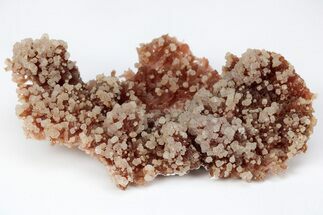This Specimen has been sold.
3.6" Manganoan Calcite and Kutnohorite Association - Fluorescent!
This is a 3.6" wide association of light-pink, manganese baring calcite (manganoan calcite) and kutnohorite. It was collected from Wessels Mine in the Kalahari manganese fields of South Africa. Under both short and long-wave UV light, the calcite fluoresces a vibrant red-pink color.
It comes with an acrylic display stand.
It comes with an acrylic display stand.
About Manganoan Calcite
Manganoan Calcite, also known as Mangano Calcite or Pink Calcite, is a variety of calcite rich in manganese, giving it a distinctive pink color that ranges from soft pastel to vibrant rose hues. The presence of manganese not only colors the mineral but often creates fluorescent qualities under UV light, where Manganoan Calcite emits a lovely pink or red glow. This mineral is usually found in massive, granular forms or in well-defined rhombohedral crystal structures, with a silky or vitreous luster.
Primarily sourced from locations like Peru, Bulgaria, and China, Manganoan Calcite is valued both for its beauty and metaphysical properties.
Manganoan Calcite, also known as Mangano Calcite or Pink Calcite, is a variety of calcite rich in manganese, giving it a distinctive pink color that ranges from soft pastel to vibrant rose hues. The presence of manganese not only colors the mineral but often creates fluorescent qualities under UV light, where Manganoan Calcite emits a lovely pink or red glow. This mineral is usually found in massive, granular forms or in well-defined rhombohedral crystal structures, with a silky or vitreous luster.
Primarily sourced from locations like Peru, Bulgaria, and China, Manganoan Calcite is valued both for its beauty and metaphysical properties.
About Calcite Crystals
Calcite crystals are a form of calcium carbonate (CaCO₃) known for their diverse shapes, transparency, and vibrant range of colors. They typically form in rhombohedral, scalenohedral, or prismatic shapes, often with well-defined, sharp edges and glossy surfaces. Calcite crystals are often translucent or transparent, sometimes displaying a double refraction effect where objects viewed through the crystal appear doubled. They can appear in various colors—white, clear, yellow, pink, blue, green, and orange—depending on impurities or trace minerals.
A notable characteristic of calcite is its reaction with weak acids like vinegar, which causes it to effervesce, or fizz, as it releases carbon dioxide. This property makes calcite crystals a key tool in geological identification and studies. Calcite forms in many environments, from sedimentary rocks like limestone and marble to hydrothermal veins.
Calcite crystals are a form of calcium carbonate (CaCO₃) known for their diverse shapes, transparency, and vibrant range of colors. They typically form in rhombohedral, scalenohedral, or prismatic shapes, often with well-defined, sharp edges and glossy surfaces. Calcite crystals are often translucent or transparent, sometimes displaying a double refraction effect where objects viewed through the crystal appear doubled. They can appear in various colors—white, clear, yellow, pink, blue, green, and orange—depending on impurities or trace minerals.
A notable characteristic of calcite is its reaction with weak acids like vinegar, which causes it to effervesce, or fizz, as it releases carbon dioxide. This property makes calcite crystals a key tool in geological identification and studies. Calcite forms in many environments, from sedimentary rocks like limestone and marble to hydrothermal veins.
Kutnohorite is a rare calcium manganese carbonate with the chemical formula Ca(Mn,Mg,Fe)(CO3)2. It is common for magnesium and/or iron to substitute themselves for manganese, resulting in different colors or crystal shapes.
SPECIES
Calcite var. Manganoan Calcite & Kutnohorite
LOCATION
Wessels Mine, Kalahari Manganese Fields, Northern Cape Province, South Africa
SIZE
3.6 x 2.3"
CATEGORY
SUB CATEGORY
ITEM
#169795
 Reviews
Reviews














